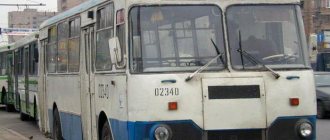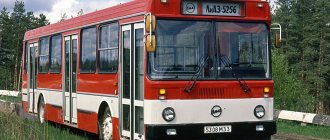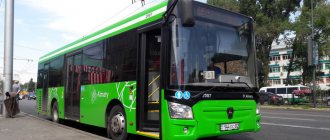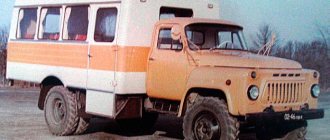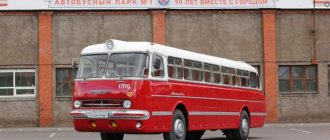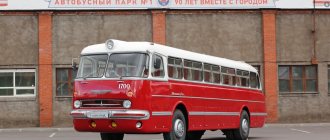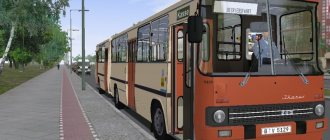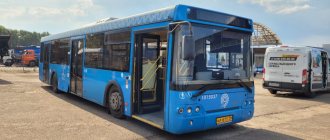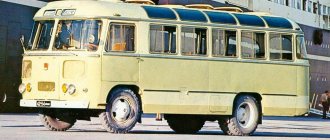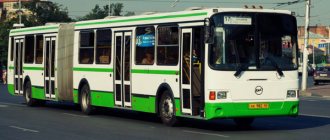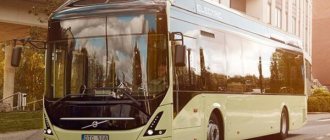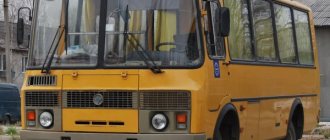Author: zaMKADpride
June 14, 2016 08:11
Tags: LiAZ 677 LiAZ buses
12169
22
This bus has become one of the symbols of public transport of the former USSR - few people are not familiar with this big, pop-eyed beast. Now many people also know about its technical features, such as automatic transmission, and those who are especially advanced even know what made the famous “clanging of empty bottles” when moving. Well, now it’s time to talk about how it was born and what modifications of this machine worked for the benefit of man.
0
Source:
See all photos in the gallery
In the photo: ZIL-158
0
Source:
In 1958, production of ZIL-158 buses was transferred from the Likhachev plant in Moscow to the Likinsky Machine-Building Plant, which in those years produced components for Moscow trucks. Since that time, the plant in Likino-Dulevo was renamed LiAZ. The first buses left the production gates in January 1959, and during production until 1970, over 62,000 copies were manufactured. The outdated design was also criticized by drivers who sat next to the engine and constantly breathed gasoline vapors, and in the summer they were also fried by the heat from the engine. Another legend was the unsynchronized manual transmission with a complex activation mechanism, which is why the driver of the “158” was very tired by the end of the shift. Well, passengers did not like the narrow wing doors, which greatly worsened the rotation during rush hour.
×
The beast crawls out of the garage
0
Source:
Then, 7 years ago, the incredible happened: my Krasnodar friends managed to agree with the institute that the old LiAZ would be provided for a whole day for a trip around the city with a group of transport enthusiasts. This is not the first time that local transport workers have practiced this: in the old days in Krasnodar people gathered for rides on something that was sold out every year, while rarities remained in use; but before that, buses were provided by transport companies - and, characteristically, completely free of charge. But due to the long-term lack of other 677s in Kuban, the organizers of the event in 2012 had to turn to the happy owners of this very car - and they also succeeded.
In the photo: ZIL-158V
0
Source:
In 1960, LiAZ designers, with the support of NAMI, built an experimental bus ZIL-E158D, equipped with a hydromechanical gearbox developed by a Moscow institute and a new suspension on air springs. A number of elements tested on the experimental design subsequently formed the basis of the modernized ZIL-158V bus, which received a new synchronized gearbox, a stronger clutch and an improved parking brake system. Buses of the ZIL-158 model were produced until 1970, and for several years the 158 shared the conveyor line with the new model. Work continued in the area of improving passenger boarding on the bus.
Modifications: sanitary, accordion and others
Before the release of model 677, the plant specialists produced several prototypes, which are not modifications of the base model, but require consideration.
In 1960, LiAZ designers, with the support of NAMI, built an experimental ZIL-E158D , equipped with a hydromechanical gearbox developed by the Moscow Institute and a new suspension on air springs. A number of elements tested on the experimental design subsequently formed the basis of the modernized ZIL-158V bus, which received a new synchronized gearbox, a stronger clutch and an improved parking brake system. ZIL-158 was produced until 1970, and for several years the 158 shared the conveyor line with the new model. Work continued in the area of improving passenger boarding on the bus.
In the same year, 1960, another experimental LiAZ-NAMI-E158 , equipped with four wing doors. Later, this temporary measure, which was never considered successful, was developed in experimental buses of the LiAZ-676 series. The new buses were built on the chassis of the same ZIL-158, but differed from the latter in a different external design, a new, more powerful V8 engine from the ZIL-130, a hydromechanical transmission and power steering.
Restored LiAZ-677M. Photo Wikipedia
LiAZ-5E-676, built in 1962, 15.5 meters long. However, the ZIL engine for a heavy and long vehicle turned out to be weak, and the articulation unit was difficult to manufacture. This attempt turned out to be the last opportunity in the Union to build a new “accordion”, and in the following years the legendary Hungarian Ikarus were actively supplied to the Soviet PATP.
Analyzing the experience of building experimental buses, NAMI and LiAZ almost immediately realized that a modern bus could be built only by abandoning the outdated ZIL-158V body. The development of a new generation bus began in 1960, and the first prototype was released on November 6, 1962 - on the Anniversary of the Revolution. In the factory documentation, the new generation high-capacity city bus received the index LiAZ-677.
LiAZ-677M. The creation of the LiAZ-677M with increased technical and operational indicators was assigned to the plant as part of the R&D plan for 1973. However, only towards the end of the IX Five-Year Plan a technical project was developed and the first two prototypes of the modernized bus were built (one of them with a ZIL-375YaF pre-chamber-torch engine). In 1976 they successfully passed acceptance tests. In 1977, taking into account the comments of the USSR Ministry of Aviation Administration, another prototype of the LiAZ-677M was manufactured, after which the revised documentation was issued for production.
In reality, it only came down to the production of two pilot batches of 10 buses in 1977 and 25 in 1978. Moreover, buses of the same year had a number of noticeable differences in the design of doors, overhead bars, radiator hatch, overhead marker lights, as well as in the decorative design of the front end.
The release of a batch of 100 buses planned for 1979 was disrupted due to the refusal of the USSR Ministry of Automobile Transport to agree on the wholesale price for the LiAZ-677M. Serial production of the LiAZ-677M was established only in 1982. During production, the bus gradually changed its appearance to one more familiar to us today.
The “entry/exit” windows above the doors were replaced by “false windows”, which disappeared by 1984, and two horizontal stripes appeared in their place. By the second half of 1985 lighting technology was updated and began to comply with UNECE rules. Back in 1978, LiAZ-677 received front direction indicators of a new type, orange square-shaped, installed on the front wall of the bus above the main headlights. Now they have been added to the rear square lights, assembled in a vertical section.
The front and then rear overhead marker lamps also changed. By the beginning of 1985, rear and front metal bumpers began to be installed on buses, and buses produced at that time were distinguished by the presence of bumpers, but also with the old round rear lights. The final appearance of the LiAZ-677M was formed by 1986.
After this, buses continued to be produced without any significant changes. The last LiAZ-677M rolled off the assembly line at the Likinsky plant in 1994 , after which the assembly line on which they were assembled was dismantled. However, after the production of the 677 was curtailed at the “native” plant until 2002, it continued to be produced in small batches at various auto repair plants , in particular, in Bor, in Petrozavodsk, at the Yakhroma bus station in Orekhov-Zuevo. In Tosno, under the symbol ToAZ-677D, until 2002, a slightly modified modification of the LiAZ-677M, equipped with a Yaroslavl engine, was produced. Several dozen cars were assembled at the Volzhsky Machine-Building Plant (VMZ), in the city of Rybinsk, Yaroslavl region.
Museum bus LiAZ-677M, rear view. Photo Wikipedia
After 2000, in many cities, LiAZ-677M buses began to be decommissioned en masse as obsolete, unprofitable and unsuitable for installing ASCP.
LiAZ-677B and LiAZ-677MB. LiAZ-677B - modification for suburban transportation. Buses of this modification were distinguished by a four-row seat layout , the absence of a rear storage area (passenger seats were installed instead) and the same floor level throughout the entire cabin. Ventilation hatches were made in the roof , which were not present in the original city version of the bus. Also, unlike a city bus, the commuter vehicle had a spare wheel, which was located either under the floor on the rear overhang, or on a bracket outside on the rear wall, and also sometimes in the passenger compartment on the rear platform.
The fact is that the LiAZ-677B in the event of hostilities was planned to be used as ambulance buses, the standard seats in which could easily be replaced with the stretchers included in the kit. Of course, the spare wheel in the interior, prepared for medical work, turned out to be superfluous and, according to the doctors’ requirements, was moved outside. In peacetime, the spare wheel and bracket, respectively, were stored on the territory of the ATP, and according to the rules, to replace the wheel it was necessary to call a technician from the park.
The number of seats in the LiAZ-677B was 35, the nominal capacity was 67 passengers, and the maximum capacity was 87 passengers.
LiAZ-677B was produced from 1973 to 1978, after which it was replaced by a slightly modernized version of LiAZ-677MB, produced until 1994. The main characteristics and features of these modifications are the same.
LiAZ-677V (1970-1975) - excursion modification. It had only one door to the passenger compartment and a spare tire on the rear wall. It was equipped with a special guide seat and comfortable passenger seats with headrests. Released in a small series. Number of seats - 37 plus a guide seat.
LiAZ-677A, LiAZ-677MS and KAvZ-3100. LiAZ-677A - a modification for areas with cold climates (from −60 to +40 °C), was distinguished by the presence of thermal insulation of the body and a 4-row seat layout . The number of seats in the LiAZ-677A was 34, the total capacity was 66 passengers. The prototype LiAZ-677A was released in 1967; small-scale production began the following year, and later mass production.
In 1982, instead of the LiAZ-677A, its modernized version, LiAZ-677MS (based on the LiAZ-677M), began to be produced. They differed from their predecessors by double glazing. The number of seats was 29, the nominal capacity was 74 passengers, and the maximum capacity was 101 passengers.
KAvZ-3100 “Siberia” is a bus shortened by one window section for areas with cold climates. Didn't go into the series.
LiAZ-677P (1974-1975) - apron, had two doors to the passenger compartment on each side of the body. This bus only had ten passenger seats. The total capacity is 75 passengers, the maximum is 110. Three prototypes were manufactured .
LiAZ-677G is a gas-cylinder bus running on liquefied petroleum gas. Outwardly, it did not differ from the usual LiAZ-677; gas cylinders were installed under the cabin floor on the left side. Experimental models appeared in 1974, mass production began in 1983.
LiAZ-5930 is a mobile television station. Photo Wikipedia
LiAZ-5930/LiAZ-5931/LiAZ-5932 “Magnolia”. LiAZ-5930 is a special bus - a mobile television station PTS-CT "Lotos" with a full set of equipment. The body is all-metal, welded. The walls and roof are thermally insulated. There are two doors in the body: one on the right side, the other at the back. The doors have retractable ladders. Two blind windows are covered with light-proof curtains.
The TV bus is heated by a radiator in the engine cooling system. Four fans operate while driving; In addition to them, there is an air conditioning system with two KT-4 units and power from an external power supply. The air taken by the air conditioners from the body passes through cabinets with special television equipment and, after cooling, is again directed through the ceiling ducts into the body. The air conditioning system has an adjustable intake of outside air through grilles in the side walls. Each air conditioner is controlled automatically.
PTS 5930 was produced in two versions - for black and white and color broadcasts. Video recording equipment was also installed. In the back there was a table, tripods, cabinets, portable seats, telephones, consoles for the video engineer, sound engineer and director, a cabinet with spare parts and accessories, and a power input. In the luggage compartments there is a shield of audio cables, transformers, stabilizers, a cable winding mechanism, television cameras, cable drums. In addition, the body housed 6 more folding and 5 swivel seats, adjustable in height, and clothes hangers. A stable position of the body during operation of the PTS is created by supporting devices.
The all-metal closed thermally insulated cabin is an integral part of the body. It contains controls and controls. Perhaps the most distinctive thing about this car is the roof. It is used as a platform for television equipment, and operators with transmitting cameras worked here. The maximum weight of equipment and people who can be on the platform at the same time is 400 kg. The equipment is lifted using a winch with a lifting capacity of 60 kg.
Technical characteristics of LiAZ-5930:
- External body dimensions – 10,540 × 2500 × 3550 mm
- Internal body dimensions – 8702 × 1989 × 2362 mm
- Front wheel track – 2100 mm
- Rear wheel track – 1880 mm
- Lowest ground clearance – 210 mm
- Curb weight – 9860 kg
- The total weight of the OB van for color television is 14,530 kg
- The total weight of the PTS for black and white television is 14,290 kg
- The production of the Magnolia PTS was launched for the 1980 Olympics; Soviet pts worked alongside the German Bosh Fernsehen and French Thomson-CSF.
LiAZ-677
0
Source:
Analyzing the experience of building experimental buses, NAMI and LiAZ almost immediately realized that a modern bus could be built only by abandoning the outdated ZIL-158V body. The development of a new generation bus began in 1960, and the first prototype was released on November 6, 1962 - on the Anniversary of the Revolution. In the factory documentation, the new generation high-capacity city bus received the index LiAZ-677.
0
Source:
In addition to the new wagon-type body, developed completely from scratch, the new product received a powerful 180-horsepower ZIL-375YA7 gasoline engine, borrowed from the Ural-375 truck, which, unlike its army version, was derated for A-76 gasoline and received new heads blocks and another carburetor. It was thanks to this engine that the LiAZ-677 bus became notorious for its fuel consumption, which could reach 50 liters per 100 km. The consumption was also aggravated by the new two-stage hydromechanical automatic transmission LAZ-NAMI-Lvov 22.17, which, due to the poor build quality of the torque converter, was prone to oil loss and overheating. The box was controlled by a key block on the front panel. To improve the smoothness of the ride, a dependent suspension of all wheels on air springs was used, and to increase the driver’s comfort, they tried to isolate the engine next to it as much as possible. To increase passenger capacity, the LiAZ used a three-row interior layout and a rear storage area with a lowered floor level and a ramp, and better rotation of passengers at stops was ensured by two pneumatic doors of increased width. In total, the bus could accommodate up to 110 passengers, 25 of whom were seated.
0
Source:
A year later, the experimental bus was presented to the State Commission for Automation and Mechanization, which, after examining the bus, gave it a positive assessment. Traction, technical, running and climatic tests of the prototype were carried out in 1965, for which several vehicles were sent on a test run Moscow-Kharkov-Novorossiysk-Sochi-Tbilisi-Erevan-Ordzhonikidze-Moscow. In 1966, three more experimental buses were built, and the entire first batch of five vehicles was transferred for trial operation to Moscow automobile plants, where they received generally positive reviews from the operators. Everyone understood that the machines presented for accountable use were still “raw” and had “childhood diseases.” The plant resolved problems as quickly as possible. Due to increased deformation and subsequent destruction of the main load-bearing elements, the body frame was almost completely redesigned, which made it possible to improve the rigidity of the bus, and the suspension kinematics and mounting points for the levers were completely revised. The material of the air spring shell has also changed, the first of which tended to burst under heavy loads.
0
Source:
Serial production of a pilot batch of buses built using bypass technologies began in 1967, and already in 1968, in order to reduce the weight of the bus and increase its corrosion resistance, some of the external elements of the body skin were made of duralumin sheets, which were attached to the frame with riveting. A number of sidewall elements were made from them (on the left - a sheet under the driver's door and separate sheets to the stern, on the right - sheets between the passenger doors and on the side of the cabin) and the central part of the rear panel, and several more sheets of duralumin were located on the roof. Despite all the advantages of duralumin, by 1982, after modernization, they decided to get rid of the expensive material: even in PATP, during repairs, in most cases steel sheets were installed on buses. Another factor was savings and improved manufacturability of production: riveting of sheets was done manually, and with the production of 10,000 buses per year, the labor costs of the employee turned out to be enormous. LiAZ-677 moved to the main conveyor, two years later completely displacing the veteran LiAZ-158V. For the creation of the bus, the team of plant workers was awarded VDNKh medals, where one of the prototypes was exhibited in the Mechanical Engineering pavilion. In 1972, the new Soviet bus was shown at the International Fair in Leipzig, where it received a 1st degree diploma and the Great Gold Medal of the exhibition.
0
Source:
By the way, since 1973, buses of the brand have been exported. Mostly LiAZ-677E went to the Warsaw Pact countries, but a certain number of vehicles also ended up in Cuba. They also worked in the GDR. For the needs of urban transport, from 1973 to 1979, 370 LiAZ-677 buses were purchased, which subsequently operated in small regional centers. In order for the bus to pass certification on the German market and meet all requirements and standards, the lighting equipment had to be completely changed. At the front, rectangular headlights appeared, which were installed on the Moskvich-412, and the place of the standard round taillights was taken by new square ones.
In 1976, the Likinsky Bus Plant was awarded the Order of the Red Banner of Labor for organizing the production of new bus models and early implementation of the five-year plan. Of course, almost every year some changes were made to the bus. So, in 1977, new speakers appeared in the cabin, an increased power generator with a built-in relay-rectifier, and already in 1978, an anti-icing system for pneumatic system hoses appeared, emergency shutdown of the “mass” with buttons in the cabin and on the body, as well as a sliding window in the right window driver's cabin.
Story
In 1958, due to the specialization of the automobile plant named after. Likhachev, at the production of trucks, a resolution was adopted to transfer the production of buses from ZIL to the Likinsky Machine-Building Plant (LiMZ), which from that time became known as the Likinsky Bus Plant - LiAZ.
Interior of the LiAZ-677 bus. Photo Wikipedia
In January 1959, on the opening day of the 21st Congress of the CPSU, the first two LiAZ-158 vehicles left the factory gates. In 1961, LiAZ reached ZIL's bus production capacity, and then exceeded it by more than 1.5 times. Over 10 years, LiAZ produced 50 thousand buses (158 series).
The design of the new city bus LiAZ-677 began in 1962. The process used the developments of the designers of ZIL (Likhachev Plant) and LAZ (Lviv Bus Plant) - two production associations that at that time had the greatest experience in the design and production of large-class buses. And already in the fall of the same year, 1962, the first prototype was built . On November 7, he took part in a festive demonstration in the town of Likino-Dulevo near Moscow.
The following year, the new bus was presented to the State Commission for Automation and Mechanization under the USSR Council of Ministers, which gave it a positive assessment. In the summer of 1964, 2 experimental buses of the new model were tested on mountain roads in the vicinity of Sochi. The following year, testing continued in laboratories, and a run along the route Moscow – Kharkov – Novosibirsk – Sochi – Tbilisi – Yerevan – Ordzhonikidze – Moscow took place.
It should be noted that the Likinsky Bus Plant had by that time turned into a large production association. So, in 1965, LiAZ already produced 6,200 LiAZ-158 buses with 5,152 operating. And in the same year, the development of a large-capacity city bus (for 110 passengers) of a new model, the LiAZ-677, was officially completed. In the fall of 1966, the new machine was accepted by the state commission and recommended for mass production. Also in 1966, 3 more samples were manufactured, and all 5 LiAZ-677s that existed at that time were transferred to Moscow automobile plants for trial operation on the streets of Moscow.
During 1967, pilot production batches were produced. One bus from this batch was sent to the USSR Exhibition of Economic Achievements, where it was demonstrated in the Mechanical Engineering pavilion. For the creation of LiAZ-677, a large group of plant workers were awarded Exhibition medals. At the beginning of next year, the plant began mass production. In May 1968, the bus was shown at the international exhibition Interbytmash-68, where it attracted a lot of public attention.
In the spring of 1968, serial production of new model cars began on the LiAZ assembly line. In 1971, mass production of new buses began, and their production doubled during the Ninth Five-Year Plan.
In 1972, at the International Fair in Leipzig, LiAZ-677 was awarded a Big Gold Medal and a 1st degree diploma. In 1975, 10,188 LiAZ-677 buses rolled off the assembly line; 7,837 people worked at the plant. In addition, during 1975, 48 above-plan LiAZ-677 were produced.
On February 16, 1976, the Likino Bus Plant was awarded the Order of the Red Banner of Labor for the achievements achieved in increasing production efficiency, organizing the mass production of new bus models and early completion of the tasks of the ninth five-year plan.
Bus LiAZ-677M. Photo Wikipedia
In 1978, the LiAZ-677 was modernized and received the designation LiAZ-677M. The changes affected mainly the interior trim and exterior design of the body (bumpers, roof hatches, new lighting fixtures appeared). In the early 1980s, buses began to be painted yellow. And for more than 15 years, the LiAZ-677M was produced by the plant without any major changes.
Most of today's passengers remember this magnificent bus just like that - an exceptionally smooth ride and surprisingly comfortable seats, a cabin spaciousness that is unique for peak hours, a warm interior even in the coldest weather, route indicators that never freeze or fog up, a bright, festive yellow or red body color. .
Production of LiAZ-677 in Likino continued until August 7, 1994. In total, about 200 thousand buses of the LiAZ-677 family were manufactured. 7133 pieces were exported to 16 countries.
Production of the LiAZ-677 was finally stopped at the Likinsky Bus Plant in 1994 due to the dismantling of the assembly line. But despite this, until 2004, buses were produced in small batches at auto repair plants in Russia.
For a long time, LiAZ-677 was assembled at car repair plants in Yakhroma near Moscow and the city of Bor, Nizhny Novgorod region. The bus was also assembled piece by piece by the Remtekhmash plant, located in the town of Orekhovo-Zuevo, adjacent to Likino-Dulevo. And LiAZ itself, until recently, produced so-called first-configuration bodies - with a fully equipped interior. The Tosnensky Automobile Repair Plant also produced this bus. In addition, a modified LiAZ-677M was produced in Tosno, but there it received a slightly different name - ToAZ-677D, since it was equipped with a Yaroslavl diesel engine.
LiAZ-677M
0
Source:
LiAZ engineers started thinking about serious modernization of the bus back in the mid-1970s. In 1975, a pilot batch of 35 buses was built, which featured a different front design with a plastic grille, and the door leaves were made of aluminum alloy. Inside, the main change was a new truss frame with increased rigidity. In the photo: LiAZ 677M pre-production
0
Source:
0
Source:
Changes also affected the transmission. The hydraulic transmission has been significantly strengthened, and the installation of a rubber coupling has reduced vibration levels and increased the service life of universal joints. New components appeared in the braking system, which allowed it to meet modern safety requirements. Buses began to be equipped with sunroofs, initially typical only for suburban modifications, “entry/exit” windows above the doors disappeared, replaced by a blank steel panel, some side windows were turned into emergency ones and were deprived of vents, and the old rear axle of the Hungarian company Raba was replaced with a modern one of the same brand, with different gear ratios, reinforced gearbox and axle shafts. To improve the driver's working conditions, new sealing materials were used, which made it possible to minimize gas pollution and noise in the cabin. The entire pilot batch went into operation at the Moscow automobile plants. It is known that several “Emoks” worked for many years in the first, second and fifth bus depots of the capital. However, the new front mask was considered unprofitable to produce, so the serial LiAZ-677M, put into production in 1982, differed from the “regular 677s” by an additional grille for cooling the engine at the front and a single ocher-yellow paint scheme, for many years years, which became the main one for the model.
0
Source:
Since 1984, new front and rear bumpers began to be installed on the bus, and new lighting equipment appeared that meets international requirements. At the rear, square lights appeared, consisting of four headlights: side lights, brake lights, reversing lamps and turn indicators, and at the front, in 1986, the front upper lights were replaced with rectangular ones. Changes also affected the interior. The driver got a new seat with its own suspension, adjustable in height, length, backrest and cushion tilt, the ventilation system and interior trim were changed: some of the elements were made of low-flammability plywood, and the seats were reupholstered with leatherette.
LiAZ-677B
The main modification of the bus that entered the assembly line in Likino in 1973 was the suburban LiAZ-677B. The bus differed from its “urban” counterparts in its four-row interior layout and the same floor level in the cabin. Sometimes it is mentioned that the main difference between the 677B externally and the urban version is the bracket for mounting the spare wheel at the rear of the body. Actually this is not true. The bracket was part of the standard equipment of any production bus. The fact is that in the event of hostilities, the LiAZ-677 was planned to be used as ambulance buses, the standard seats in which could easily be replaced with the included stretchers. Of course, the spare wheel in the interior, prepared for medical work, turned out to be superfluous and, according to the doctors’ requirements, was moved outside. In peacetime, the spare wheel and bracket, respectively, were stored on the territory of the ATP, and according to the rules, to replace the wheel it was necessary to call a technician from the park. In the photo: LiAZ-677B
0
0
0
0
The welded frame for all buses was the same; an additional section of the high floor was welded onto the standard frame. LiAZ engineers thought out a design that was maximally unified with the body of the existing urban version, without major changes to the production line, which, of course, would reduce the number of buses produced, while the country needed an increasing number of them every year. The rear truss contains guides for joining the floor frame for suburban modification. Two more guides are hidden in the area of the rear arches. To create a section of a flat floor, a frame was developed, welded from square pipes. To secure it to the power side members and body trusses, additional docking points were introduced, which were not dismantled if the bus was an urban modification. To accommodate the spare wheel under the floor, a hatch was constructed in the rear of the body, secured with two separate locks. For maximum unification in production, it was brought into line with the battery compartment hatch. For the same purpose, front door leaves were installed on suburban modifications, because the floor height in this case was identical to the front part. In total, the commuter version could accommodate up to 87 passengers, of which 35 were seated. Modification 677B was produced from 1973 to 1978; subsequently, its place on the assembly line was taken by the modernized version LiAZ-677MB, which had a similar design.
LiAZ-677A
0
Source:
Especially for areas with a cold climate (from – 60 °C), the northern modification 677A was developed (after the modernization of the LiAZ-677MS), which differed from its analogues in double glazing, thermal insulation and a four-row interior layout. Buses were produced to order in small batches. To solve problems with increased fuel consumption, bus modifications were developed that ran on liquefied gas and were produced in small batches. The LiAZ-677G differed from its gasoline counterparts in a box with three gas cylinders on the roof, as well as reduced engine power due to the conversion to gas and, as a result, lower passenger capacity.
LiAZ-677P
0
Source:
Based on the LiAZ-677, there were other interesting modifications, for example, a sightseeing bus with one door, a four-row interior layout and a seat for a guide, as well as an improved interior ventilation system and separate lighting shades, which never went into production so as not to create competition. Lviv buses. Another interesting modification was the LiAZ-677P apron bus, built in 1974 in the number of three prototypes. Unlike its counterparts, it had two doors to the cabin on each side of the body and only ten passenger seats. Additional doors and a low number of seats make it easier for passengers with luggage to get on and off the bus, and the travel time is no more than five minutes from the airliner's ramp to the airport apron. However, the bus was not widely used. The main reason for the refusal was the high floor, which made it difficult for passengers to board and disembark, as well as the small capacity by aviation standards. The LiAZ-677P could serve the Tu-134 or Tu-154, but for the more capacious airbuses Il-62 and Il-86 it was necessary to use two buses.
LiAZ-677P quickly found a replacement in the form of the APPA-4 road train, which was a passenger semi-trailer with a low (350 mm) floor level and a ZIL-130 tractor. The first LiAZ-677 often had problems with the automatic transmission, the professional repair of which was mastered by the mechanics of city enterprises. As a rule, airport automobile enterprises did not have specialists in automatic transmissions, which is why the transmission was repaired in specialized technical centers, which also prolonged equipment downtime. In the case of APPA-4, there were no such problems - the repair of service ZIL-130s was well mastered, and in the event of a breakdown, the tractor was easily replaced with another.
New time
The topic of specialized airfield equipment in the 1990s was one of the first to be raised by Alterna LLP, which developed an articulated bus with double-sided passenger doors. Tests of Alterna-7202 were carried out in 1993 at Moscow Domodedovo Airport and showed the rather low reliability of the new product.
In the same 1993, the Uritsky Trolleybus Plant introduced the Trolza-6020 apron road train with a one-way layout, consisting of a ZIL-4421 tractor and a passenger semi-trailer made using body elements from ZiU-682 trolleybuses. The originality of the design lay in the one-and-a-half-story design of the passenger compartment: the front part of the semi-trailer rose above the fifth-wheel coupling device, and a small staircase led to access it. The only copy of Trolza-6020 was transferred for work to the Sovetsky airport, located in the Khanty-Mansiysk Autonomous Okrug.
The Latvian company LAS-1, which became the legal successor of Riga plant No. 85, in 1999 created a double-sided ASP road train based on the ZIL-4421 tractor and a low-floor semi-trailer of modern design, in which design elements of MAZ-103 city buses were visible. The train could carry up to 130 air passengers and had 16 seats. It was not put into mass production.
In 1999, the design studio “MaDe Project”, with the participation of scientific and technical specialists, developed a design project for the “Lada Transfer” passenger road train. The prototype was made in 2001. It is based on the ZIL-130V1 truck tractor and the APPA-4 semi-trailer chassis, provided by Kurumoch Airport (Samara). The original road train remains in a single copy.
The Lvov Bus Plant, which updated its model range in the first half of the 2000s, added the AeroLAZ in 2004 - a 12-meter low-floor bus equipped with six double-leaf doors, four of which were located on the right side, and two on the left. It is known that at least 8 copies of AeroLAZ were produced, 3 of them operate at the airports of Kemerovo and Lvov.
In 2007, specialists from the Minsk Automobile Plant created a full-fledged apron bus MAZ-171, which in its operational characteristics is not inferior to world analogues. Initially, the rather expensive new product was received with skepticism, however, after a few years, mass orders began to pour in. At the moment, more than 120 machines of this model have been manufactured. At the end of 2022, the first copy of the second generation Minsk apron vehicle, MAZ-271, was sent to the Kiev Boryspil airport.
At the XIII International Aviation and Space Salon MAKS-2017, the Neftekamsk Automobile Plant showed for the first time the airfield NefAZ-5299-40-52. This is a variation of the classic low-floor city bus in a five-door design (two double doors are installed in the center of the left side of the body), similar in design to the above-mentioned AeroLAZ. Naturally, such a bus is deprived of many of the advantages that full-fledged apron vehicles have, but at the same time it is able to compete with them due to a more reasonable cost.
Part 1 Part 2
LiAZ-5930 PTS-4/LiAZ-5931 Lotus/LiAZ-5932 Magnolia
0
Source:
Separately, it is worth talking about mobile television stations built on the basis of the LiAZ-677 bus. In 1964, in connection with the commissioning of the television center under construction in Ostankino and the introduction of new generation television equipment, work began on the development of a mobile television station on the chassis of the new LiAZ-677 bus. In 1972, the first two specialized buses under the name PTS-4 were produced at the television plant in Siauliai. The station was intended to record television broadcasts from cultural events taking place on the street: concerts, rallies, parades. The chassis of the LiAZ-677 bus was equipped with a new all-metal welded van-type body, the walls and roof of which had additional thermal insulation. The roof of the bus was used as a platform for camera operators to operate. The reinforced steel panel could support up to three people and television equipment. To lift operators, a ladder was provided at the rear of the body, and to lift the necessary equipment, a winch with a lifting capacity of 60 kg was used. To ensure that the bus stood stably on the surface during operation, the driver extended outrigger support devices. Inside the bus there were consoles for the director, video engineer and sound engineer, six folding and five swivel seats, hangers with clothes, a table, a telephone and two wardrobes. To increase the comfort of working inside the bus, a forced ventilation system was developed that uses heat from the engine radiator for heating in winter, and in summer the cabin was cooled by two KT-4 air conditioners, powered in parking lots from an external network. The luggage compartments contain transformers, cable winding mechanisms and a shield for audio cables. The special bus LiAZ-5931, which received its own name “Lotos”, differed from the early model 5930 only inside: the Lotus had equipment for recording color pictures for television. The cars were produced in small batches at the Siauliai plant until 1974, where they were subsequently replaced by a new television station, designated LiAZ-5932 Magnolia. It differed from its predecessors in its improved television equipment, thanks to which it could immediately transmit live broadcasts. The Magnolia plant produced small batches until 1982.
0
Source:
Separately, it is worth noting that to service the PTS, an auxiliary bus was used, which accompanied the station during operation and was a converted LiAZ-677 for transporting television cameras, tripods, cables and other necessary equipment. In addition, the bus was used as a utility room for station staff, and only the front three-seater sofas were usually left in the passenger compartment.
